
Restorations improve maritime park
SAN FRANCISCO — Just beyond the scenic green hills of the Golden Gate National Recreation Area sits a section of the San Francisco Bay that looks as though it hasn’t evolved since the early 1900s.
Historic vessels rock softly in the docks of the Hyde Street Pier while visitors walk in and out of warehouses and brick buildings that previously housed canneries.
“I just wanna see the boats already!” A young boy screams as he pulls his mother outside by her sleeve. In the flash of time it takes him to run through the lobby of the Visitor Center, reality sets in and the current time period becomes clear.
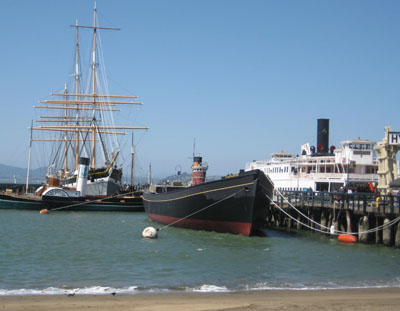 |
Hyde Street Pier is home to the historic vessels that are a main attraction in the Maritime National Historical Park. Pictured here are Hercules (front), a tugboat built in 1907, Eppleton Hall (middle), a steel tugboat built in 1914, and Balcutha (last), a square-rigged ship built in 1886 (Photos by Erin Schlissel). |
The park is devoted to educating visitors about the maritime history of San Francisco and how significant this port city was to the history of the United States. Acquired in 1988 by the National Park Service, the Maritime park hosts more than four million visitors each year.
With the intense amount of foot traffic that treads through buildings and on boats that date back as far as 1886, maintenance and restoration are frequent practices necessary for keeping the park in its best condition. However, contemporary renovation procedures won’t cut it here.
Maintenance and restoration activities must be historically accurate in order to maintain the historic look and feel of the structures. While some tools that may not have been available at the original time of construction are now put to use for efficiency’s sake, many materials and methods of working on the boats are the same ones from the time the structure was built.
With regards to working on the boats in Hyde Street Pier, restoration activities require that workers not only come from a maritime background, but they must also be willing to learn the true fundamentals of the trade.
“It is hard for us to find people who 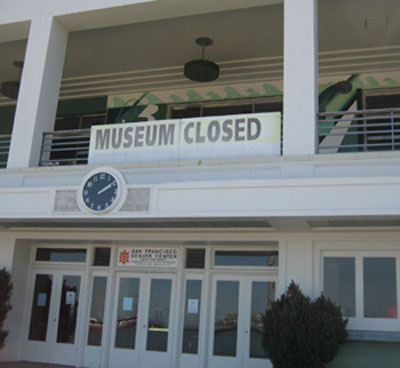 have those skills, so one of our missions is to preserve those skills by teaching young workers how to work on the boats,” said Lynn Cullivan, the park’s management analyst and public affairs officer.
have those skills, so one of our missions is to preserve those skills by teaching young workers how to work on the boats,” said Lynn Cullivan, the park’s management analyst and public affairs officer.
“What makes something like this so extensive is you can’t use modern fastening materials or laminates, you have to do it the way they did back then to keep it authentic, so workers come here and they learn how to do that.”
|
Above, a large sign indicates to visitors that the museum is temporarily closed (Photos by Erin Schlissel). Below, a portion of the vibrant underwater scene that wraps around the interior walls of the Maritime Museum. The murals are currently being restored after enduring 70 years worth of grime. Painted by Hilaire Hiler in the 1930s, the scene is his vision of the lost city of Atlantis. In an effort to prevent bicyclists from biking through the walking path that is narrower as a result of construction, large orange barricades were placed at both ends of the path. Bleachers shown below are being replaced. Last, the underwater mural by Hiler is shown in more detail with exhibits removed. |
When a boat requires maintenance, it is placed on a dry dock to be worked on. The amount of time that is spent working on a boat depends on how active that vessel is. The only boat that leaves the dock and has some activity is the Alma schooner. Built in 1891, this flat-bottomed schooner that once transported cargo between San Francisco and Delta farming communities, now takes small trips around the bay and is worked on once a year.
The four other boats in the park are stationary so they are worked on about every five years. The Barclutha, a Scottish ship built in 1891, recently underwent $1 million worth of repairs. The C.A. Thayer, another schooner that brought in raw materials to build San Francisco in the early 1900s, was just placed back in the pier after being in dry dock for three years. The Thayer’s hull was completed, but work still needs to be done on the upper part of the structure.
In addition to the boats, the historic buildings in the park also require a lot of attention. Currently, the Aquatic Park Bathhouse Building, which houses the San Francisco Maritime Museum, is closed until October 2009.
Members of the Works Progress Administration, an organization created by the 1930s New Deal to employ architects and artists affected by the Great Depression, built the Streamline-Moderne style building in 1936. The building was originally designed to be a public bathhouse, and was later transformed into a maritime museum in 1948 after it was occupied by troops during World War II. The building has endured a great deal of wear and tear over the years, and it is long overdue for a makeover.
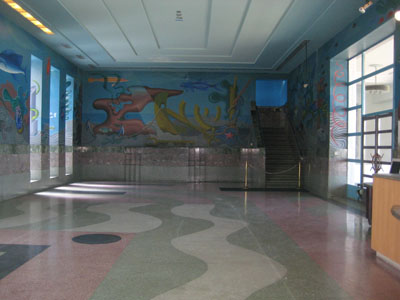 “The Aquatic Park Bathhouse was completed 70 years ago and some major systems were failing. Due to the nature of WPA projects, there were many unskilled laborers involved in the original construction and some construction details were not as well designed as they should have been,” said Robbyn Jackson, the park’s chief of Cultural Resources & Museum Management.
“The Aquatic Park Bathhouse was completed 70 years ago and some major systems were failing. Due to the nature of WPA projects, there were many unskilled laborers involved in the original construction and some construction details were not as well designed as they should have been,” said Robbyn Jackson, the park’s chief of Cultural Resources & Museum Management.
The building is currently enduring the second phase of restoration. The first phase was completed last fall, when 90 percent of the windows and doors were replaced and the roof was completely redone. All of the replacements to the structure came as close to matching the original pieces as possible.
“The same methods are not required but the same look and feel of the finished product must be the same,” said Jackson. “In the case of the stainless steel clad windows that were replaced, the original windows were constructed in shops on-site. Our architect initially designed a new, improved window system that would largely be constructed the same way, but due to the skyrocketing price of steel at the time, we were forced to change to a more modern window system that is close, but not exactly the same as the original. The new system provided the same look, improved structural strength and uses less stainless steel.”
In order to train maintenance workers in historically accurate restoration practices, all workers are shown a sensitivity video that teaches them about methods of caring for historical landmarks.
“The 15-minute video allows them to work on premises and gives them a special ‘Trained’ sticker for their hardhats. No sticker — no work,” said Jackson.
To supplement what is taught in the video, a supervisor who has two-years of experience in working on historical sites under his or her belt is assigned. This person works closely with the maintenance crews and constantly updates them on restoration issues that are forthcoming.
The second phase of restoration includes two major projects. Murals that adorn the interior walls of the museum are being restored and bleachers located on either side of the Bathhouse Building, are getting some much-needed repairs.
“Completion of the bleachers should be to the end of the contract, October 2009. Then they’ll open up the building and exhibits should be coming in over the next two or three years,” said Cullivan.
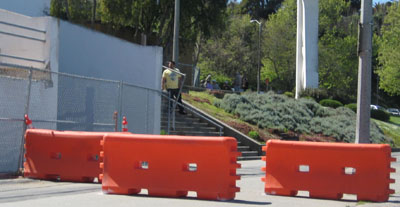 The museum’s murals are as much part of the history of San Francisco as the museum itself. The colorful images of sea life and a whimsical idealized depiction of the lost city of Atlantis were painted by Hilaire Hiler, an acclaimed muralist and illustrator.
The museum’s murals are as much part of the history of San Francisco as the museum itself. The colorful images of sea life and a whimsical idealized depiction of the lost city of Atlantis were painted by Hilaire Hiler, an acclaimed muralist and illustrator.
After moving to San Francisco in the 1930s, he was hired by the Works Progress Administration to paint the walls of the Bathhouse.
During the past 70 years, the murals have become dirty and worn by water that seeped into the museum through leaky windows. A local art restorer has been hired by the park to perform the restoration work.
“They tend to cram as many exhibits in as can, so a lot of the walls and art are usually covered up,” said Cullivan, conveying some sadness in his voice. “The artist conceived it to seem like you were going underwater when you came into this building. There’s a soft greenish glow, you look like you are underwater.”
In addition the museum’s murals, an even greater task is restoring the bleachers that are located outside of the building. The urban beach site adjacent to the museum, which is one of only a few urban beaches in San Francisco, is popular among locals and tourists who attend triathlons and concerts and utilize the bleachers. Therefore, it is crucial that the bleachers are repaired so they are as safe as possible. In addition, the bleachers will be more accessible for people with disabilities once the repairs are completed.
“The waterproofing had failed over time and saturation with salty air had damaged much of the rebar and spalled concrete. The east bleacher structure was the worst due to the interior having a partial sand floor and many years of inadequate ventilation,” Jackson explained.
While the bleachers are receiving their facelift, the paved pathway that is shared by bicyclists, joggers and walking pedestrians will be more crowded with metal fencing and barricades. A fence has been erected to keep visitors out of the way of construction and it extends about a yard out into the path. Due to the resulting narrower path, large rectangular orange barricades have been put in place to dissuade bikers from riding through the path and possibly colliding with visitors who are on foot.
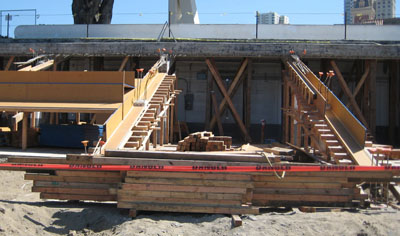 “People were surveyed before renovations started, and they said it was a good idea,” said Cullivan. “The biggest headache is for the bicyclists. The museum is working with the bicycle community to try to encourage people to walk their bikes through the area.”
“People were surveyed before renovations started, and they said it was a good idea,” said Cullivan. “The biggest headache is for the bicyclists. The museum is working with the bicycle community to try to encourage people to walk their bikes through the area.”
At the exact moment he finished speaking, a bicyclist zoomed through the pathway.
“Walk your bike please,” he yelled. The biker immediately stepped off her bicycle and walked it the rest of the way. Cullivan looked victorious and continued. “They realize what we’re doing and they’re working with us. There haven’t been any big problems.”
The current renovations will cost about $20 million, but the hefty price tag seems well worth the decades of recreation and education that the museum, its neighboring amphitheater, and the ancient vessels alongside the pier will provide to the visitors each year.
If You Go:
For more information on the San Francisco Maritime National Historical Park, visit the park’s main website at http://www.nps.gov/safr/.
Or contact the Visitor Center at 415-447-5000.
Directions to the park by car:
From the South Bay (San Francisco International Airport / U.S. 101): Take 101 north. Follow the signs to 101 North Golden Gate Bridge. Take the Mission Street exit, at the bottom of the ramp go right on Mission Street, in two blocks go left on Van Ness Avenue, follow Van Ness Avenue (north) about 30 blocks. Turn right on North Point Street (east), then turn left on Polk Street (north). The Museum Building is straight ahead.
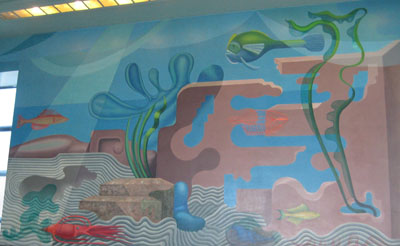 From the East Bay (Bay Bridge): After crossing the bridge take the Harrison Street/Embarcadero 2B exit. At the bottom of the ramp turn right (north). Turn left onto the Embarcadero. Follow the flow of traffic past Pier 39 and on to Jefferson Street. Hyde Street Pier is about five blocks up on the right. To reach the Museum Building, turn left on to Hyde Street and take the next right on to North Point Street. The museum is two blocks down (west) on the right.
From the East Bay (Bay Bridge): After crossing the bridge take the Harrison Street/Embarcadero 2B exit. At the bottom of the ramp turn right (north). Turn left onto the Embarcadero. Follow the flow of traffic past Pier 39 and on to Jefferson Street. Hyde Street Pier is about five blocks up on the right. To reach the Museum Building, turn left on to Hyde Street and take the next right on to North Point Street. The museum is two blocks down (west) on the right.
From the North Bay (Golden Gate Bridge / Marin): Follow the Lombard Street exit. Drive east on Highway 101 through the Presidio. Bear to the right and get on Lombard. In about a mile and a half turn left (north) on to Van Ness Avenue. In four blocks turn right (east) on to North Point Street, and then left (north) on Polk Street to the Museum Building.
There is street parking available with meters that accept coins and there are several garages that vary in price (range from $10-$20 per day).
Operating Hours and Seasons:
Visitor Center (corner of Jefferson and Hyde Streets/ 499 Jefferson)
9:30 a.m.- 5:30 p.m. (May 25- June 21)
9:30 a.m.- 6:30 p.m. (June 22- August 16)
9:30 a.m.- 5:30 p.m. (August 17-Sept 30)
9:30 a.m.- 5 p.m. (October 1-May 24)
Closed on Thanksgiving, Christmas and New Year’s Days.
Hyde Street Pier (Foot of Hyde Street/2905 Hyde St.)
9:30 a.m.- 5:30 p.m. (last entry 5 p.m.) (May 25- June 21)
9:30 a.m.- 6:30 p.m. (last entry 6 p.m.) (June 22 – Aug. 16)
9:30 a.m.- 5:30 p.m. (last entry 5 p.m.) (Aug. 17 – Sept. 30)
9:30 a.m.- 5 p.m. (last entry 4:30 p.m.) (Oct. 1- May 24)
Closed on Thanksgiving, Christmas and New Year’s Days.
Aquatic Park Bathhouse Building & Maritime Museum
While the building is closed for renovation, guided tours are available every Thursday and Saturday at 11 a.m. Call the Visitor Center at 415-447-5000 for more information.
Fees:
A ticket is necessary to board the vessels in Hyde Street Pier. Tickets are $5 and are good for seven days. A ticket is not required for children under the age of 16 to enter the vessels. Tickets can be purchased at the booth located on the pier. For more information, contact the visitor center at 415-447-5000.

Comments are Closed